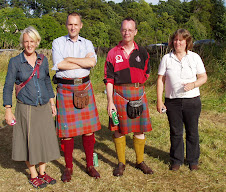Yesterday I put the newly-acquired VKB in its place in my collection. Does anybody want the old one? Jean at milesandmiles dot demon dot co dot uk? Free, of course. It’s really in pretty good condition – I could have saved my money.
Nope -- Blogger's not doing scanned images, again. See above, I hope.
My notes say that it is the issue for Spring, 1955: I was an undergraduate in Glasgow, getting seriously into knitting. I had knit in high school, in Asbury Park New Jersey, miserable lumpy objects (as I was); not at all during my four years at Oberlin; and then in Glasgow I started again, because everybody was doing it. I knit two whole things (“whole” == “I finished them”) from this issue of the VKB. How on earth did I have time? Both patterns still seem pretty nice.
This issue also beautifully illustrates one of my big grudges against life – any woman of nearly-73 will know what I mean. When I was young, the Object of the Game was to be 30 and to look like Barbara Goalen. When I got to be 30, the rules suddenly changed: now you had to be 17, and look like Twiggy or Jean Shrimpton.
Since I’ve got the scanner going, I also offer a pattern from the near side of that great gulf. I didn’t, alas, date it when I bought it, but the price is marked as “6d”, and the change to decimal currency happened in the late 60’s, so it must be nearly 40 years old. It’s been somewhere towards the top of my HALFPINT list ever since, but I've never knit it. It would be fun even now, and not too difficult. I was already too old for it when I bought the pattern, and teen-agers nowadays don’t wear sweaters much. That doesn’t explain why I didn't knit it for one of my daughters.
The KBTH list came up with this pattern yesterday. Oh dear, oh dear. But if I order just the pattern and not the very tempting yarn, I can think of using some of my stash. The designer must have Sharon's book: those Paisley motifs could have no other source. But it’s still wonderful.
My sister’s shawl
Thank you for the help with my stitch-count problem. I have solved it in the simplest and clumsiest way: I picked up stitches up slipping the pick-up needle through the links in the chain, one by one; and then increased up to the desired count by an utterly primitive knit-front-and-back in the necessary number of stitches in the succeeding garter stitch rows. I’m now launched into the first tier of Amedro’s edging roundels, and I think all is well. The pick-up line looks neat, and the increases are lost (I tell myself) in the ensuing garter stitch.
But I wish I’d read your comment before I did it, Sherry. I think your method of picking up the thread between stitches was better. I feared that I might get a nudibranch-type ruffle, by any method, but I think that’s not happening.
And I wondered all day why I have no memory of this problem – I’ve knit this shape to Amedro’s instructions no fewer than three times before – and she says to slip the first stitch of each row, so she, too, must have only half as many links in the edge-chain as she requires stitches to be picked up. But when I read your comment, Ted, memory stirred. I think in the past I have picked up two stitches from each link in the chain, probably by knitting the front and back threads separately instead of doing it your very neat way.
Subscribe to:
Post Comments (Atom)




This comment has been removed by a blog administrator.
ReplyDeleteHi Jean
ReplyDeleteI had no idea you ever lived in New Jersey. What on earth were you doing there? It's a long way from Glasgow. I grew up just a few miles from Asbury, and spent a great deal of time each summer on the boardwalk (now gone, along with most of the other things that made it fun).
Jean! You went to Oberlin! Well, say hey to that. I graduated in the late 1970s. No knitting going on in my day, tho I understand there's quite a bit there now. And at college campuses all over.
ReplyDeleteI lost the beginning of the thread, but I understand there was a Vogue pattern you were looking for? I inherited my grandmother's collection of patterns from about 1920 to 1960 or so, and I'd be happy to check.